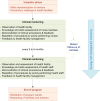On-site clinical mentoring as a maternal and new-born care quality improvement method: evidence from a nurse cohort study in Nepal
- PMID: 31920460
- PMCID: PMC6950904
- DOI: 10.1186/s12912-019-0396-1
On-site clinical mentoring as a maternal and new-born care quality improvement method: evidence from a nurse cohort study in Nepal
Abstract
Background: We describe an on-site clinical mentoring program aimed at improving emergency obstetrical and new-born care (EmONC) in Nepal and assess its effectiveness on nurses' knowledge and skills. In Nepal, both the maternal mortality ratio (MMR, 239/100,000 live births) and the neonatal mortality rate (NMR, 21/1000 live births) were among the highest in the world in 2016, despite impressive progress over recent decades considering the challenging environment.
Methods: From September 2016 to April 2018, three experienced nurses conducted repeated mentoring visits in 61 comprehensive or basic EmONC centers and birthing centers located in 4 provinces of Nepal. Using updated national training manuals and teaching aids, these clinical mentors assessed and taught 12 core EmONC clinical skills to their nurse-mentees. Clinical mentors worked with management mentors whose goal was to improve the nurses' working environment. We assessed whether the cohort of nurse-mentees performed better as a group and individually performed better at the end of the program than at baseline using relevant tests (chi-square test, Wilcoxon matched-pairs signed-rank test, and Kruskal-Wallis equality-of-population rank test).
Results: In total, 308 nurses were assessed, including 96 (31.2%), 77 (25.0%) and 135 (43.8%) who participated in all three, two or only one mentoring session, respectively. In total, 225 (73.0%) worked as auxiliary nurse-midwives (ANMs), while 69 (22.4%) worked as nurses. One hundred and ninety five (63.3%) were trained as skilled birth attendants, of which 45 (23.1%) were nurses, 141 (72.3%) were auxiliaries and 9 (4.6%) had other positions. The proportion of ANMs and nurse-mentees who obtained a knowledge assessment score ≥ 85% increased from 57.8 to 86.1% (p < 0.001). Clinical assessment scores increased significantly for each participant, and therefore for the group. SBA-trained mentees had better knowledge of maternal and new-born care and were better able to perform the 12 core clinical skills throughout the program.
Conclusions: Our study suggests that on-site clinical mentoring of nurses coupled with health facility management mentoring can improve nurses' clinical competences in and performance of maternity and new-born care. Assessing evidence of impact on patient safety would be the next stage in evaluating this promising intervention.
Keywords: Asia; Emergency obstetrical and new-born care; Human resources for health; Maternal and new-born care; Mentoring; Nepal.
© The Author(s). 2020.
Conflict of interest statement
Competing interestsThe authors declare that they have no competing interests.
Figures
Similar articles
-
Using a mobile nurse mentoring and training program to address a health workforce capacity crisis in Bihar, India: Impact on essential intrapartum and newborn care practices.J Glob Health. 2020 Dec;10(2):021009. doi: 10.7189/jogh.10.021009. J Glob Health. 2020. PMID: 33425333 Free PMC article.
-
Combining an experiential learning model and interprofessional peer-mentoring to improve maternal and neonatal health: Lessons learned from Indonesia.Educ Health (Abingdon). 2022 Sep-Dec;35(3):89-95. doi: 10.4103/efh.EfH_375_20. Educ Health (Abingdon). 2022. PMID: 37313888
-
Nurses' and auxiliary nurse midwives' adherence to essential birth practices with peer coaching in Uttar Pradesh, India: a secondary analysis of the BetterBirth trial.Implement Sci. 2020 Jan 3;15(1):1. doi: 10.1186/s13012-019-0962-7. Implement Sci. 2020. PMID: 31900167 Free PMC article.
-
Mentoring the working nurse: a scoping review.Hum Resour Health. 2020 Jul 29;18(1):52. doi: 10.1186/s12960-020-00491-x. Hum Resour Health. 2020. PMID: 32727573 Free PMC article.
-
Mentors' self-assessed competence in mentoring nursing students in clinical practice: A systematic review of quantitative studies.J Clin Nurs. 2020 Mar;29(5-6):684-705. doi: 10.1111/jocn.15127. Epub 2019 Dec 23. J Clin Nurs. 2020. PMID: 31794105
Cited by
-
Socio-technical challenges in accessing antenatal services during pregnancy complications in Ecuador and the opportunities for digital health.Digit Health. 2025 Jun 9;11:20552076251343684. doi: 10.1177/20552076251343684. eCollection 2025 Jan-Dec. Digit Health. 2025. PMID: 40510190 Free PMC article.
-
Multidomain and multilevel strategies to improve equity in maternal and newborn health services in Nepal: perspectives of health managers and policymakers.Int J Equity Health. 2023 May 26;22(1):105. doi: 10.1186/s12939-023-01905-7. Int J Equity Health. 2023. PMID: 37237251 Free PMC article.
-
Policies and actions to reduce maternal mortality in Nepal: perspectives of key informants.Sex Reprod Health Matters. 2021;29(2):1907026. doi: 10.1080/26410397.2021.1907026. Sex Reprod Health Matters. 2021. PMID: 33821780 Free PMC article.
-
Assessment of health system readiness for routine maternal and newborn health services in Nepal: Analysis of a nationally representative health facility survey, 2015.PLOS Glob Public Health. 2022 Nov 21;2(11):e0001298. doi: 10.1371/journal.pgph.0001298. eCollection 2022. PLOS Glob Public Health. 2022. PMID: 36962692 Free PMC article.
-
Service availability and readiness for basic emergency obstetric and newborn care: Analysis from Nepal Health Facility Survey 2021.PLoS One. 2023 Aug 17;18(8):e0282410. doi: 10.1371/journal.pone.0282410. eCollection 2023. PLoS One. 2023. PMID: 37590204 Free PMC article.
References
-
- Ministry of Health, Government of Nepal, New Era. The DHS Program, ICF, Rockville, Maryland, USA . Nepal Demographic and Health Survey - 2016. 2017.
-
- Government of Nepal, National Planning Commission . Nepal - Sustainable Development Goals Status and Roadmap 2016-2030. 2017.
LinkOut - more resources
Full Text Sources
Miscellaneous


